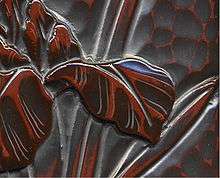Kamakura-bori
Kamakura-bori (鎌倉彫) is a form of lacquerware from Kamakura, Japan. It is made by carving patterns in wood, then lacquering it with layers of color. It is then polished.


The genre is said to date to the Kamakura period, when Kōun (康運) (or, according to another theory, Kōen (康円), a busshi (a sculptor specializing in Buddhist images), began carving racial Buddhist implements in the manner that Chin Na-kei (or Chin Wa-kei) had introduced from Chinese carved lacquer of the Song Dynasty in China, which until modern times always built up the lacquer on a flat base surface before carving.
Kamakura-Bori was typically produced for the ruling class of feudal Japan, and often depicts religious/political figures. Kamakura-Bori was for all people who owned a home: almost all home-owners had some form of Kamakura-Bori crafts.
See also
- 鎌倉彫 (Kamakura-bori) in the Japanese Wikipedia.